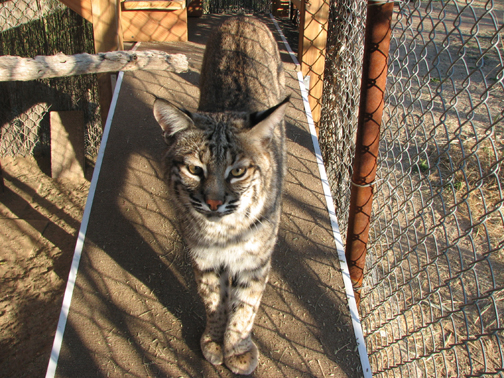|
This bobcat is a resident at the Tucson Wildlife Center. Desert Duets: Bobcat Info Web Page Information about Bobcats Purr... Meow... Hiss... It's a cat, but it's not a house cat! Although bobcats make many of the same sounds as house cats, don't confuse this fierce wild animal for a pet. Bobcats are the most common wildcat in North America. They are most common in the West where they live in canyons, forests, and rocky, bushy areas. Most cats, including house cats, have long fluffy tails. The bobcat gets its name from its short tail that is only four to seven inches long. Its tail is striped with a black tip and white underside. The bobcat's fur is reddish tan. It has spots and bands of darker brown or black fur. The fur around the bobcat's face and neck is called a "ruff." The "tufts" on the end of its ears stick straight up. In Arizona, bobcats have tufts but less ruff than their cousins in other parts of the country. Bobcats have white spots on the backs of their ears. The white fur on the female bobcat's ears and tail help bobcat kittens follow their mothers in the dark. Bobcats have sharp claws and teeth. They keep their claws sharp by scratching on trees. A bobcat can pull in its claws so it can walk silently on its padded feet. Bobcats have a good sense of balance and can walk gracefully on tree branches and narow rock ledges. They use their sharp teeth for hunting and eating their prey. They lick themselves to stay clean. Like house cats, they have excellent night vision which helps them hunt. Also like house cats, bobcats lay their ears back when they are angry. A bobcat's' ears do not swivel like a cat's ears do. Bobcats have to turn their heads to hear better. Bobcats stake out their territory; they use urine to mark the boundaries. They hunt within their territory, or expand their territory if they can't find enough to eat. Bobcats are most active at night and often hunt at dawn or dusk. They eat rabbits, birds, and mice. Sometimes, they eat larger prey such as deer. Bobcats are patient hunters. They can wait for hours before they pounce on their prey. After killing their prey, bobcats find a safe place to eat, away from other animals.
|
